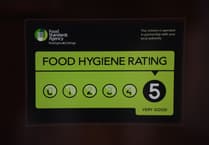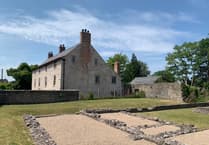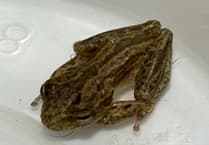AN OLD sailor who survived one of the most controversial naval disasters of World War II has made his last official visit to Brittany in honour of his 460 shipmates who lost their lives, including two fellow Foresters.
Ninety-three-year-old John Eskdale of Whitecroft was a 19-year-old marine aboard HMS Charybdis when she was sunk by German torpedoes in the Channel in the early hours of October 23, 1943.
Most of the sailors and marines who died that night 75 years ago were listed as ‘lost at sea’.
But for weeks after the disaster, dozens of bodies were washed up in a 200sq mile area along the French coast and the beaches of Guernsey and Jersey.
There were only 107 survivors, with John one of the last two to be rescued, after nearly five hours in the water.
With 40 officers and men also losing their lives on the destroyer HMS Limbourne, the total death toll was around 500.
John, who co-founded the Charybdis Association in 1973, has attended commemorative services in Brittany every five years since, but he accepts that this year’s official visit will have to be his last.
“You don’t see the graves, you see the people,” he said. “It’s sad to think of all those young men who never lived their lives. The first casualty buried on Guernsey had only joined the ship that afternoon.”
The local cemeteries, with their designated Commonwealth War Grave areas, are difficult to find and receive few visitors. The visit last month marked the 75th anniversary of the sinking – with John the only one of the three remaining survivors able to attend.
Among those who died were John’s Gunnery Officer Walter Wildin from Bream and Able Seaman William Haines from Lydney, and the commemorations this year were attended by representatives from Lydney Royal Naval Association and Royal British Legion, including their standard bearers and RBL chairman Ian Hendy.
Services, attended by many local people, were held at the cemeteries in Dinard, and St Brieuc and the monument at Perros Guirec, the nearest spot on land to where the wreck of HMS Charybdis was found by French divers in 1993.
The Charybdis was part of Operation Tunnel, leading “a mixed bag” of six destroyers in a sweep west of the Channel Islands hoping to surprise an E-boat escorted German convoy.
The operation was heavily criticised at the subsequent inquiry for sending a unit with no collective training against a highly-trained fighting force.
“Our destroyers had been patrolling the area two or three times a month and the Germans knew all about them. Added to that we had never worked with the destroyers before and the Germans had superior communications. We were sitting ducks,” said John.
“We had picked up the approach of enemy ships and were at action stations when the first torpedo hit our port side. We immediately started listing and a 30ft wave came over us, throwing me to the deck and washing the first casualty overboard.
“Within minutes the second torpedo hit, knocking out our electrical power. The ship split in two and sank within half an hour.”
The best swimmers tried to make it to shore but they were drowned by the currents. Many more died in the cold, oily water while awaiting rescue.
John, who wasn’t a good swimmer, survived by clinging to bits of wreckage and rubber dinghies. He was covered from head to foot in diesel oil which took months to get off his skin.
Controversially, other ships were desperately attempting to tow the HMS Limbourne (which was eventually scuppered) to safety while the Charybdis survivors were in the water.
“We shouldn’t have been involved in the operation at all. We’d just come back from the Med waiting to have the boilers cleaned and go on shore leave, but were called up because another cruiser had engine trouble,” said John, who returned to active service after just two weeks’ “survival leave” and became a commando with Royal Marines special forces.
He was one of many survivors who were hastily despatched to the Far East to prevent them telling their stories of the disaster.
In addition to joining all the official visits to Brittany for 45 years, he has regularly attended the annual Charybdis Commemoration Weekend on Guernsey.
The event honours not only the sailors and marines who lost their lives, but also the bravery of the islanders who defied the German occupying forces by attending the funerals and laying wreaths.
John married in 1947 and he and his late wife Barbara had two sons, Jonathan and Christopher, now a chaplain with the French Gendarmes, who attended the ceremony in full uniform
John retired from the Bradford-on-Avon Police having attained the rank of inspector, and still collects for the Poppy Appeal in Lydney every year.
By a ‘one in a million chance’ on a visit to Portsmouth dockyard in the 1970s he met David Royle, the shipmate who, with him, was the last to be pulled from the water. The pair went on to co-found the Charybdis Association.
The family of William Haines, who died in the disaster, were issued with his medals after the war and donated them to Lydney RBL.
The RBL later passed them to the Charybdis Association and they were taken to Guernsey by John, where the island’s Sea Cadets have them proudly on display.




